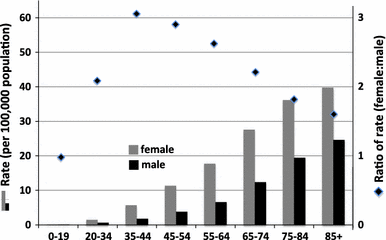Epidemiology and etiology of meningioma
- PMID: 20821343
- PMCID: PMC2945461
- DOI: 10.1007/s11060-010-0386-3
Epidemiology and etiology of meningioma
Abstract
Although most meningiomas are encapsulated and benign tumors with limited numbers of genetic aberrations, their intracranial location often leads to serious and potentially lethal consequences. They are the most frequently diagnosed primary brain tumor accounting for 33.8% of all primary brain and central nervous system tumors reported in the United States between 2002 and 2006. Inherited susceptibility to meningioma is suggested both by family history and candidate gene studies in DNA repair genes. People with certain mutations in the neurofibromatosis gene (NF2) have a very substantial increased risk for meningioma. High dose ionizing radiation exposure is an established risk factor for meningioma, and lower doses may also increase risk, but which types and doses are controversial or understudied. Because women are twice as likely as men to develop meningiomas and these tumors harbor hormone receptors, an etiologic role for hormones (both endogenous and exogenous) has been hypothesized. The extent to which immunologic factors influence meningioma etiology has been largely unexplored. Growing emphasis on brain tumor research coupled with the advent of new genetic and molecular epidemiologic tools in genetic and molecular epidemiology promise hope for advancing knowledge about the causes of intra-cranial meningioma. In this review, we highlight current knowledge about meningioma epidemiology and etiology and suggest future research directions.
Figures

References
-
- Sadetzki S, Modan B, Chetrit A, Freedman L. An iatrogenic epidemic of benign meningioma. Am J Epidemiol. 2000;151:266–272. - PubMed
Publication types
MeSH terms
Grants and funding
- CA109468/CA/NCI NIH HHS/United States
- CA109745/CA/NCI NIH HHS/United States
- CA52689/CA/NCI NIH HHS/United States
- R01 CA109468/CA/NCI NIH HHS/United States
- CA108473/CA/NCI NIH HHS/United States
- CA097257/CA/NCI NIH HHS/United States
- R01 CA109461/CA/NCI NIH HHS/United States
- R01 CA109475/CA/NCI NIH HHS/United States
- R01 CA052689/CA/NCI NIH HHS/United States
- CA109461/CA/NCI NIH HHS/United States
- R01 CA151933/CA/NCI NIH HHS/United States
- P50 CA097257/CA/NCI NIH HHS/United States
- R01 CA109745/CA/NCI NIH HHS/United States
- CA109475/CA/NCI NIH HHS/United States
LinkOut - more resources
Full Text Sources
Medical
Research Materials
Miscellaneous

